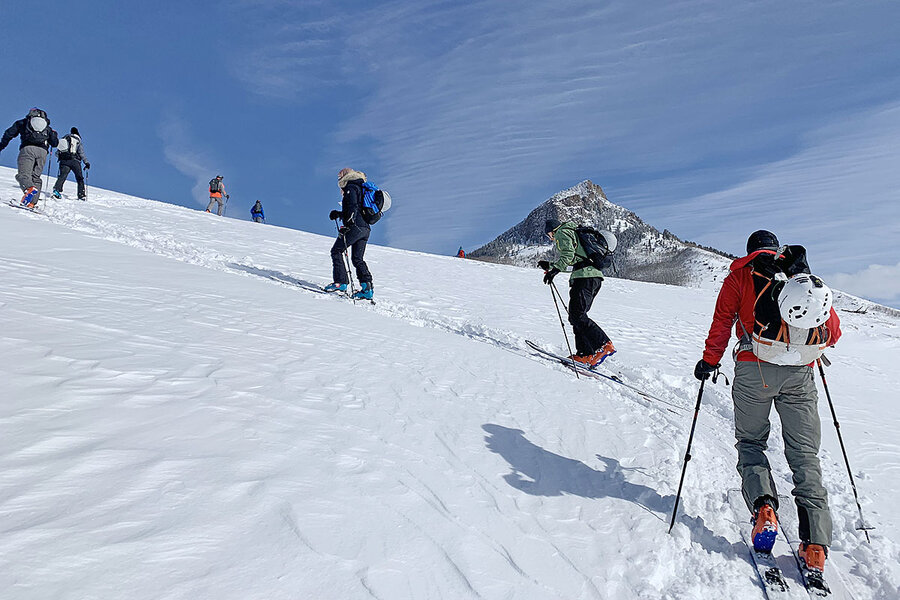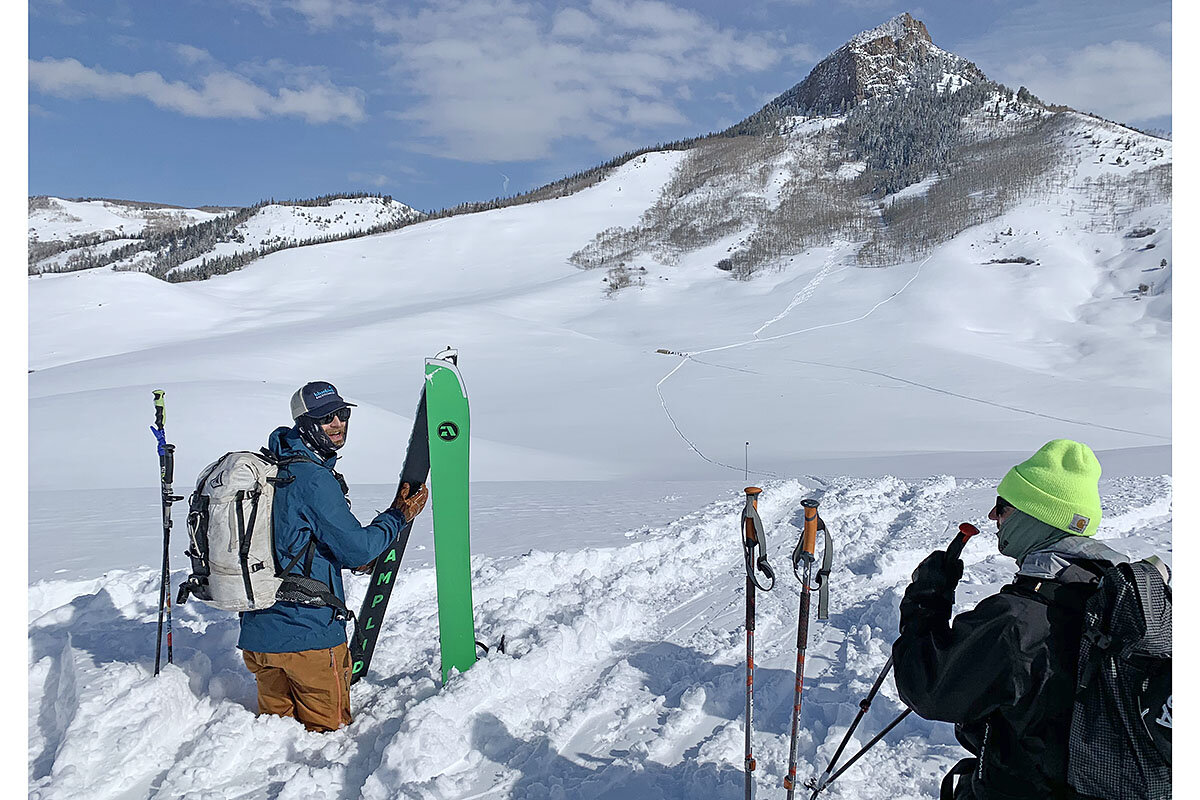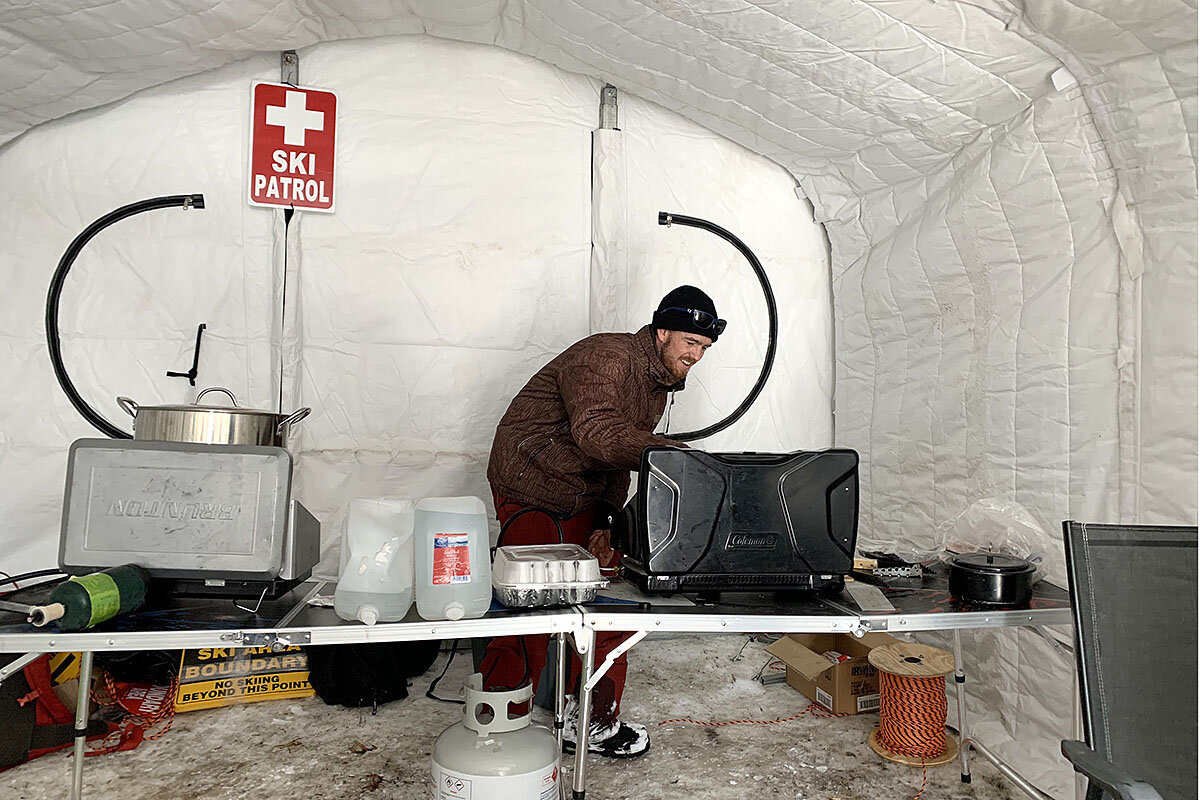Going uphill: More skiers take the sport back to its roots
Loading...
| Kremmling, Colo.
At Colorado’s newest ski area, visitors can expect abundant powder, untracked slopes, sparse crowds, and zero lift lines.
Also: no lifts.
The concept behind Kremmling’s Bluebird Backcountry is simple – and in the realm of ski areas, untested. In a world where most ski resorts emphasize their glitzy amenities, this ski area strips alpine skiing down to its bare bones.
Why We Wrote This
As ski resorts expand their glamorous amenities and lift lines lengthen, some skiers are seeking a simpler, more natural experience in the snowy mountains.
Uphill skiing is a rapidly growing trend among downhill skiers. With “alpine touring,” as it’s called, skiers install bindings that can free their heels to move uphill or click in for control on the downhill, and attach nylon “skins” to their skis for grip. Alpine touring equipment sales have risen by 388% since 2009, according to trade association SnowSports Industries America (SIA), with a particularly big spike in the past few years.
For some, the appeal of such uphill skiing lies in a return to the basics. It offers intense aerobic activity removed from the ease and glamour associated with traditional resorts. The rise in interest in this challenging, self-powered approach to skiing in the backcountry reveals a desire among some to immerse themselves in the frozen alpine environment without distraction.
In an era of multimountain passes and lift lines as long as two hours, the backcountry can be an appealing alternative, says Nick Sargent, president of SIA. “It gives them the ability to get outside, get on snow, hike, get exercise, get the beauty around them, uninhibited by snowcats, people, whatever.”
Numerous traditional ski areas – including Aspen and Snowmass in Colorado – have been embracing the uphill trends, with some allowing uphill skiers for free at any time, and others allowing them at certain times and on certain routes.
But for those seeking a more natural skiing environment, and newbies just looking to try it out, there are few entry points. The gear is specialized and expensive, lessons are not readily available, and safety in the backcountry is of utmost concern.
“I accidentally discovered [backcountry skiing] through my outdoor network,” says Erik Lambert, a co-founder of Bluebird Backcountry, sitting in Bluebird’s lodge area at the end of its opening weekend. “But not everybody has that.”
Bluebird’s “backcountry lite” approach offers beginners a place to explore getting up slopes under their own power with convenient access to rental equipment, instruction, community, ski patrol, and a more controlled environment than they’d get in the true backcountry.
“We get to introduce something that’s really special to more people, and provide an outlet for people to have a fun and different outdoor experience,” Mr. Lambert says. “People are ready to be away from the crowds.”
For its opening weekend over Presidents Day, the ski area limited visitors to around 50 a day. Those who made it were treated to mild temperatures, blue skies, and deep powder: a vision of white blanketed over the undulating wilderness of the Rabbit Ears Range.
Backcountry has always appealed to Jamie Pfahl, a public health planner from Colorado Springs, but she worries about safety, doesn’t have the gear, and considers herself a “novice-level” resort skier. She ventured to Bluebird with three friends and signed up for a backcountry lesson. As she leaves the lodge, Ms. Pfahl stops by to greet Mr. Lambert, a smile plastered on her face: “As a beginner, this was so awesome!”
Bluebird’s founders aim for the ski area to offer community and a few amenities to more seasoned backcountry aficionados, too.
“There’s a lot of knowledge here,” says Mason Moomey, a recent college graduate from Denver. “It’s a really good atmosphere.” Mr. Moomey says he and a friend came for Bluebird’s opening weekend to support the concept, make new connections, and learn new skills.
Like others with backcountry experience, the pair checks in and heads immediately for the steep ascent that leads to the roughly 400 acres of “in-bounds” terrain. Many others get fitted with rental gear and opt for a lesson.
They’re outfitted with an avalanche beacon, shovel, and probe, and either alpine touring skis or “splitboards” – snowboards that separate and act like skis for the uphill. Instructors brief them on using the safety gear, how to put the skins on their skis for uphill traction, how to shift bindings to lock heels down, and proper uphill style. That style includes a technique to cut switchbacks called a “kick turn,” an acrobatic move in which a skier sweeps one ski around so it’s facing the opposite direction, using a pole for balance.
The enthusiasm – despite a tough ascent – is palpable, and once they reach the first ridge, skiers take the skins off and cut fresh tracks down to a remote warming hut, where free hot cocoa and bacon awaits.
It’s far from clear that Bluebird Backcountry can succeed. This year, it’s relying heavily on volunteers, and Mr. Lambert and his co-founder Jeff Woodward are watching everything from skier numbers to snowpack at this location, which they’re leasing from a rancher.
“We believe the demand is there, but you never fully believe it until you see it,” says Mr. Woodward.
Others are watching, too. After photos of two-hour lift lines at Vail Resorts went viral, and skiers swapped stories of epic traffic jams on the interstate and crowds on the slopes, the notion of returning to a simpler incarnation of the sport is intriguing.
“I really like the fact that it’s another option,” says Mr. Sargent, of SIA. “There are a lot of people that would love to go to an organized liftless ski area and get away from the crowds.”
At Bluebird, Mr. Lambert and Mr. Woodward are trying to get those skiers out in a more pristine setting, too.
Backcountry is “about forming connections that you don’t normally get in a busier, more commercial place – connections with people, but also connections with nature and wildlife, connections with the spirit of winter,” explains Mr. Lambert. And, he adds, “I like the challenge and reward of getting to the top under my own power.”








